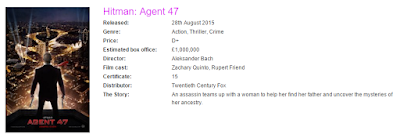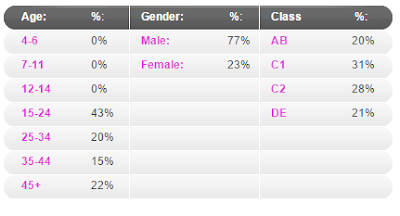Welcome back! Today, I will present research into existing products' target audience profile and present our main products target audience profile!
Outlining a target audience profile is very important to the structure of our main product, therefore we have created a detailed 'TAP' so that it reflects our choice of film classification. However, before that I will conduct some research on existing products in which I will observe their target audience data and then present our target audience profile!
THE CONJURING
The conjuring predominantly adopts the horror genre as well as thriller, in which is what genre we will be revolving our product around. Therefore, I have used this film due to it's classification in which is "15" which is our classification aim too therefore I can then observe the target audience profile and tell that the classification correlates to the majority of the audience being between the age of 15 and 24 (69%). This links to our target audience profile as our 'ideal viewer' is 20 years old, therefore he fits the bracket.
Now, let's talk about the film itself. I chose this film specifically because of the amount of low-key lighting that is within it, in which I can observe and brainstorm about how I can achieve low-key lighting in my main product in which is one of our main conventions within the film opening. Consequently, low-key lighting increases the tension towards the end of the film in which builds the horror element. Therefore, because the tension certainly scared me I must take this into consideration. However, I don't want to scare the audience, I want to make them feel feared and intrigued about what's going to happen next. Therefore, I need to be able to pick out props within the misé-en-scene in which are the catalyst for low-key lighting and identify them.
To conclude, the vast majority of props that produced the low-key lighting were lamps of a low brightness. Therefore, we might need to record the opening during the day and post edit the footage so that the lamp on the bedside table is significant and the location looks like it is in a night time setting. The reason why I might do this is because if we was to film it at night with just a lamp as a source of light, then the audience might not be able to see the character at all, in which won't make them feel feared nor intrigued. Furthermore, the film quality will be extremely grainy in which we don't want present in our main product.
HITMAN: AGENT 47


Hitman: Agent 47 adopts the action genre, however it still has a very heavy thriller feel towards the films plot and timeline throughout the film. Again, this film has the classification "15" in which we will be attempting to conduct within our film opening. However, with this movie I want to focus on the target audience profile section. Even though the classification is 15, the percentages are spread out all the way to 45+. Time for a history lesson, Hitman originated from a video game in which was platformed on PC back in 2000. Now, i'm going to be quite stereotypical here but when it comes to video games, the dominant sex is male, and this contrasts to the gender section of the target audience profile. Ultimately, what i'm saying is that since this was originally a video game and males generally play video games more than females and the fact that this game has been developed into more games and ultimately more films, means that the older generation are viewing this movie too, as well as the younger audience from the more recent video games. To conclude, this film contrasted with the video games to pull their audience in.
Now, for the film itself. I chose this film purely for the tension element. In our main product we want to express tension to fully convey the conventions of a thriller, in this film it is conveyed really well. They do this in a very simple way, close ups and tense music. Close ups of agent 47's face is shown in some situations in which tense music is played to increase the suspense of the assassination, this includes tense music in which intrigues the audience. This allows me to take inspiration from this and possibly add this to our main product in which could improve our initial ideas of building tension. Therefore, to conclude I will simply use this film as inspiration for tension.
THE PURGE: ANARCHY
The Purge: Anarchy is purely thriller. It moulds all the thriller conventions into one to make your typical thriller film. As usual, the classification is "15" which is expected after the first two pieces of research. We can also see that the classification contrasts with the 15-24 bracket age at 66%. Why? well, lets look at the the first image but more specifically, the 'The Story' section. It details 'A young couple', the reason why the highest age bracket is 15-24 is because there are a young couple as the main characters in which the majority of the audience at 15-24 can relate to and therefore form a bond in similarity because they are young and the audience is young in which changes the audiences' perspective of the film, and not in a good way. That puts the audience within the film and forces them to experience the young couples fear and trauma.
I chose this film because it ties the first two films together. The Purge: Anarchy moulds both low-key lighting and tension together. How? Well, it's very simple. Using the low-key lighting, antagonists are prevented from being seen, therefore it builds a lot of tension for the young couple in which are feared, therefore, the combination of low-key lighting and tension pin points the thriller genre perfectly. I can use this as inspiration for my main product as we are planning on using low-key lighting and tension to slowly introduce a character that cannot be seen in which the audience will feel how they felt when they watched The Purge: Anarchy.
'SOMNIUM': TARGET AUDIENCE PROFILE
With this research concluded I can now present to you a detailed target audience profile for our film 'Somnium'.
Next time: I will present film title designs! See you then!




